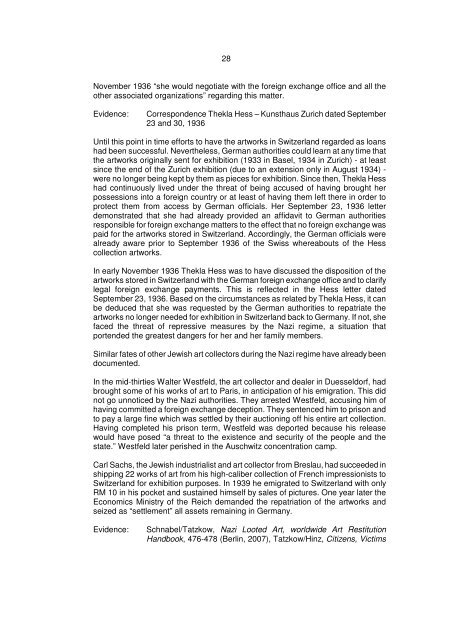Expert Opinion - Nazi Looted Art
Expert Opinion - Nazi Looted Art
Expert Opinion - Nazi Looted Art
You also want an ePaper? Increase the reach of your titles
YUMPU automatically turns print PDFs into web optimized ePapers that Google loves.
28<br />
November 1936 “she would negotiate with the foreign exchange office and all the<br />
other associated organizations” regarding this matter.<br />
Evidence: Correspondence Thekla Hess – Kunsthaus Zurich dated September<br />
23 and 30, 1936<br />
Until this point in time efforts to have the artworks in Switzerland regarded as loans<br />
had been successful. Nevertheless, German authorities could learn at any time that<br />
the artworks originally sent for exhibition (1933 in Basel, 1934 in Zurich) - at least<br />
since the end of the Zurich exhibition (due to an extension only in August 1934) -<br />
were no longer being kept by them as pieces for exhibition. Since then, Thekla Hess<br />
had continuously lived under the threat of being accused of having brought her<br />
possessions into a foreign country or at least of having them left there in order to<br />
protect them from access by German officials. Her September 23, 1936 letter<br />
demonstrated that she had already provided an affidavit to German authorities<br />
responsible for foreign exchange matters to the effect that no foreign exchange was<br />
paid for the artworks stored in Switzerland. Accordingly, the German officials were<br />
already aware prior to September 1936 of the Swiss whereabouts of the Hess<br />
collection artworks.<br />
In early November 1936 Thekla Hess was to have discussed the disposition of the<br />
artworks stored in Switzerland with the German foreign exchange office and to clarify<br />
legal foreign exchange payments. This is reflected in the Hess letter dated<br />
September 23, 1936. Based on the circumstances as related by Thekla Hess, it can<br />
be deduced that she was requested by the German authorities to repatriate the<br />
artworks no longer needed for exhibition in Switzerland back to Germany. If not, she<br />
faced the threat of repressive measures by the <strong>Nazi</strong> regime, a situation that<br />
portended the greatest dangers for her and her family members.<br />
Similar fates of other Jewish art collectors during the <strong>Nazi</strong> regime have already been<br />
documented.<br />
In the mid-thirties Walter Westfeld, the art collector and dealer in Duesseldorf, had<br />
brought some of his works of art to Paris, in anticipation of his emigration. This did<br />
not go unnoticed by the <strong>Nazi</strong> authorities. They arrested Westfeld, accusing him of<br />
having committed a foreign exchange deception. They sentenced him to prison and<br />
to pay a large fine which was settled by their auctioning off his entire art collection.<br />
Having completed his prison term, Westfeld was deported because his release<br />
would have posed “a threat to the existence and security of the people and the<br />
state.” Westfeld later perished in the Auschwitz concentration camp.<br />
Carl Sachs, the Jewish industrialist and art collector from Breslau, had succeeded in<br />
shipping 22 works of art from his high-caliber collection of French impressionists to<br />
Switzerland for exhibition purposes. In 1939 he emigrated to Switzerland with only<br />
RM 10 in his pocket and sustained himself by sales of pictures. One year later the<br />
Economics Ministry of the Reich demanded the repatriation of the artworks and<br />
seized as “settlement” all assets remaining in Germany.<br />
Evidence: Schnabel/Tatzkow, <strong>Nazi</strong> <strong>Looted</strong> <strong>Art</strong>, worldwide <strong>Art</strong> Restitution<br />
Handbook, 476-478 (Berlin, 2007), Tatzkow/Hinz, Citizens, Victims


